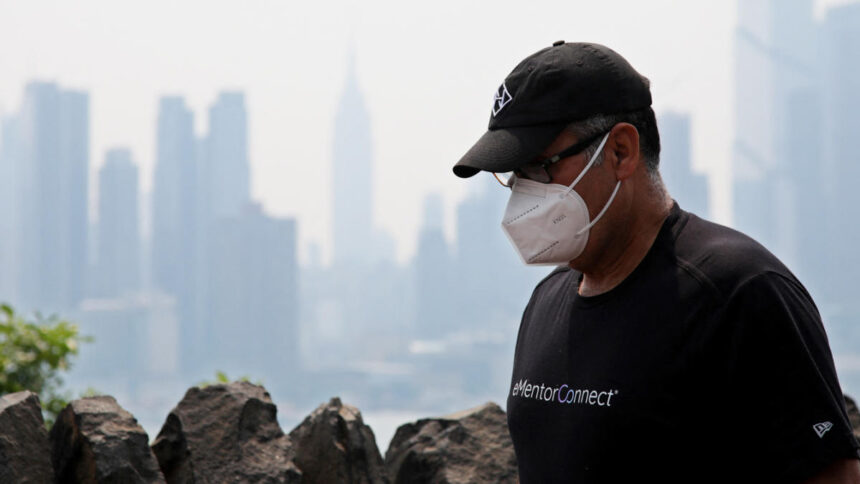Only weeks after Canadian wildfires blanketed the Northeastern United States in thick smoke, the ongoing fires are sending across the Midwest more air deemed unhealthy by the Environmental Protection Agency.
Detroit and Cleveland are currently experiencing air considered “very unhealthy,” with Air Quality Index (AQI) readings measuring more than 200.
Exposure to wildfire smoke can be harmful to human health, causing symptoms ranging from eye and respiratory tract irritation to asthma attacks and heart failure, according to the EPA.
For millions of Americans in the Eastern half of the United States, the current air quality conditions are their first exposure to severe wildfire smoke. Here are the recommendations from public health authorities on how to protect yourself:
Keep an eye on the AQI
AirNow.gov measures the presence of five major pollutants and calculates a scale from 0 to 500. You can even search for your ZIP code specifically.
Smoke can move quickly, depending on wind patterns, so when there’s smoke in your area, you may want to check a few times throughout the day, especially before planning any strenuous outdoor activities. If air quality is in the red zone, meaning that the AQI falls between 150 and 200, the air is considered unhealthy to breathe. For anything higher (purple for 200-300 and maroon for 300-500), everyone is advised to stay indoors.
For people with lung conditions such as asthma, chronic obstructive pulmonary disease (COPD) and long COVID, limiting oneself to indoor activities also applies when the air is labeled orange, for “unhealthy for sensitive groups.” Children, the elderly, pregnant women and people with heart disease are also at elevated risk, according to the EPA.
“When it’s orange, there’s concern that some people, especially those with respiratory conditions, could be impacted,” Dr. Brady Scott, a fellow at the American Association for Respiratory Care, told Yahoo News earlier this month. “When you’re in the red zone, and certainly when we’re in the purple or maroon zones, everyone is at risk, even if you are a so-called healthy person.”
Keep your indoor air clean
During wildfire smoke events, you also need to keep the indoor air clean, which means closing windows and, if necessary, using an air filtration system or single-room air purifier. Experts also advise running an air conditioner with the air recirculating within the house, rather than bringing in air from outside.
“Air purifiers with a HEPA [high efficiency particulate air] filter draw in the smoke, trap the particles and blow out clean air,” Dr. Raymond Casciari, a pulmonologist at Providence St. Joseph Hospital in Orange, Calif., told Yahoo Life.
If you cannot obtain an air purifier right away, the EPA says you can make an air cleaner by “attaching a furnace filter to a box fan with tape, brackets, or a bungee cord,” although their efficacy is not guaranteed, since research is lacking. The agency recommends changing the filters if they get dirty or smell like smoke.
Mask up outside
If you do go outside when the air is deemed unhealthy, experts encourage you to wear a mask, especially if you’ll be outdoors for a prolonged period. The same masks that work best at reducing your risk of getting COVID-19 offer the most protection against smoke.
“You want to think of the two Fs — filtration and fit. When it comes to filtration, you want a high-grade mask, whether it’s an N95 or a KF94,” Joseph Allen, associate professor at the Harvard T.H. Chan School of Public Health, told Health.com. “You want that mask snug on your face, so that all the air you’re breathing is forced to go through the filter of the mask.”
A KN95 also offers protection from wildfire smoke, but surgical and cloth masks filter less and don’t fit as tightly.
Mental health may also be affected
In the Western half of the country, where wildfire smoke is an increasingly common problem because of climate change, many residents have seen their favorite summertime activities frequently interrupted.
“In the West, we have become accustomed to the grim recurrence of weeklong, nearly annual stretches, during which wildfire smoke brings outdoor life to a virtual halt,” Yahoo News’ California-based Senior Editor David Knowles recently wrote.
If that sounds depressing, well, it is.
A 2022 study published in the journal BMC Public Health that looked at those affected by wildfires on the West Coast found that “45.3% reported anxiety due to the smoke, and 21.4% reported feeling depressed because of the smoke,” Knowles reported.
So keep an eye on your mental health, and keep hope alive: The air patterns that bring smoke to town can just as easily turn on a dime and take it away.

